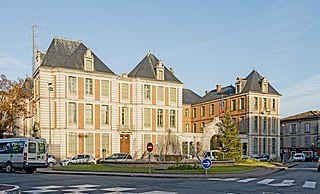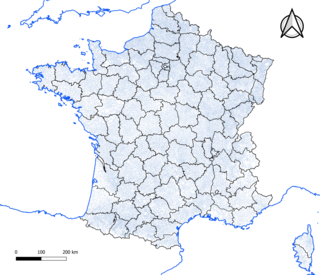
Toulouse is the prefecture of the French department of Haute-Garonne and of the larger region of Occitania. The city is on the banks of the River Garonne, 150 kilometres from the Mediterranean Sea, 230 km (143 mi) from the Atlantic Ocean and 680 km (420 mi) from Paris. It is the fourth-largest city in France after Paris, Marseille and Lyon, with 504,078 inhabitants within its municipal boundaries (2021); its metropolitan area has a population of 1.5 million inhabitants (2021). Toulouse is the central city of one of the 22 metropolitan councils of France. Between the 2014 and 2020 censuses, its metropolitan area was the third fastest growing among metropolitan areas larger than 500,000 inhabitants in France.

The Province of Languedoc is a former province of France. Most of its territory is now contained in the modern-day region of Occitanie in Southern France. Its capital city was Toulouse. It had an area of approximately 42,700 square kilometers.

Tarn-et-Garonne is a department in the Occitania region in Southern France. It is traversed by the rivers Tarn and Garonne, from which it takes its name. The area was originally part of the former provinces of Quercy and Languedoc. The department was created in 1808 under Napoleon, with territory taken from the neighbouring Lot, Haute-Garonne, Lot-et-Garonne, Gers and Aveyron departments.

The County of Toulouse was a territory in southern France consisting of the city of Toulouse and its environs, ruled by the Count of Toulouse from the late 9th century until the late 13th century.

Étienne Charles de Loménie de Brienne was a French clergyman, bishop, cardinal, politician and finance minister of King Louis XVI.

Charles Alexandre de Calonne, titled Count of Hannonville in 1759, was a French statesman, best known for being Louis XVI's Controller-General of Finances in the years leading up to the French revolution.

The commune is a level of administrative division in the French Republic. French communes are analogous to civil townships and incorporated municipalities in the United States and Canada, Gemeinden in Germany, comuni in Italy, or municipios in Spain. The UK equivalent are civil parishes. Communes are based on historical geographic communities or villages and are vested with significant powers to manage the populations and land of the geographic area covered. The communes are the fourth-level administrative divisions of France.

Henri de Montmorency, 3rd Duke of Montmorency, Marshal of France, and Constable of France, seigneur of Damville, served as Governor of Languedoc from 1563 to 1614.

Under the French Ancien Régime, a parlement was a provincial appellate court of the Kingdom of France. In 1789, France had 13 parlements, the original and most important of which was the Parlement of Paris. Though both the modern French term parlement and the English word "parliament" derive from this French term, the Ancien Régime parlements were not legislative bodies and the modern and ancient terminology are not interchangeable.
The history of Toulouse, in Occitania, southern France, traces back to ancient times. After Roman rule, the city was ruled by the Visigoths and Merovingian and Carolingian Franks. Capital of the County of Toulouse during the Middle Ages, today it is the capital of the Midi-Pyrénées region.

The Estates General of 1789 was a general assembly representing the French estates of the realm: the clergy, the nobility, and the commoners. It was the last of the Estates General of the Kingdom of France.

The ancien régime was the political and social system of the Kingdom of France that the French Revolution overturned through its abolition in 1790 of the feudal system of the French nobility and in 1792 through its execution of the king and declaration of a republic. "Ancien régime" is now a common metaphor for "a system or mode no longer prevailing".

The Capitole de Toulouse, commonly known as the Capitole, is the heart of the municipal administration and the city hall of the French city of Toulouse. It was designated a monument historique by the French government in 1840.

The Day of the Tiles was an event that took place in the French town of Grenoble on 7 June 1788. It was one of the first disturbances preceding the French Revolution and is credited by a few historians as its start.

The 1562 Riots of Toulouse are a series of events that pitted members of the Reformed Church of France against members of the Roman Catholic Church in violent clashes that ended with the deaths of between 3,000 and 5,000 citizens of the French city of Toulouse. These events exhibit the tensions that would soon explode into full civil war during the French Wars of Religion.

Occitania is the southernmost administrative region of metropolitan France excluding Corsica, created on 1 January 2016 from the former regions of Languedoc-Roussillon and Midi-Pyrénées. The Council of State approved Occitania as the new name of the region on 28 September 2016, coming into effect on 30 September 2016.

The capitouls, sometimes anglicized as capitols, were the chief magistrates of the commune of Toulouse, France, during the late Middle Ages and early Modern period. Their council and rule was known as the Capitoulate. They were suppressed in 1789 amid the French Revolution.

The Witch trials in France are poorly documented, mainly because a lot of the documents of former witch trials have not been preserved, and no number can therefore be given for the executions of witch trials in France or the true extent of them. While there is much secondary information about witch trials in France, the poor state of documentation often makes them hard to confirm.

The Handwritten Annals of the City of Toulouse, also known as the Annals of the Capitouls, were held from 1295 to 1787. They consist of a collection of books on which were recorded each year the administrative acts as well as the rights and privileges of the capitouls, the municipal consuls of Toulouse.



















